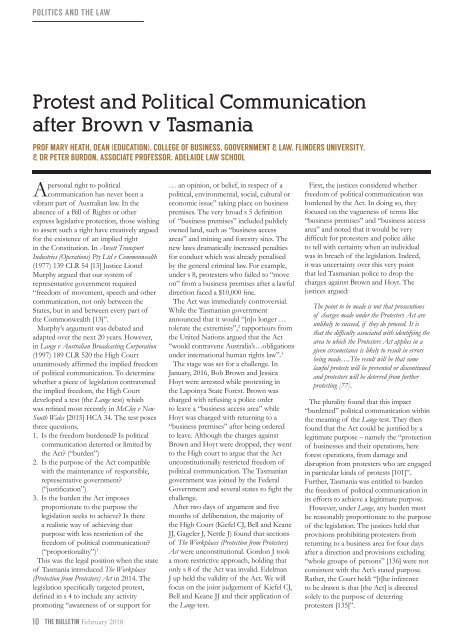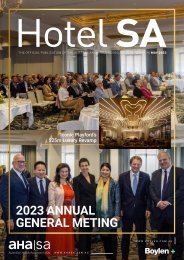LSB February 2018_Web_LSSA
Create successful ePaper yourself
Turn your PDF publications into a flip-book with our unique Google optimized e-Paper software.
POLITICS AND THE LAW<br />
Protest and Political Communication<br />
after Brown v Tasmania<br />
PROF MARY HEATH, DEAN (EDUCATION), COLLEGE OF BUSINESS, GOOVERNMENT & LAW, FLINDERS UNIVERSITY,<br />
& DR PETER BURDON, ASSOCIATE PROFESSOR, ADELAIDE LAW SCHOOL<br />
personal right to political<br />
A communication has never been a<br />
vibrant part of Australian law. In the<br />
absence of a Bill of Rights or other<br />
express legislative protection, those wishing<br />
to assert such a right have creatively argued<br />
for the existence of an implied right<br />
in the Constitution. In Ansett Transport<br />
Industries (Operations) Pty Ltd v Commonwealth<br />
(1977) 139 CLR 54 [13] Justice Lionel<br />
Murphy argued that our system of<br />
representative government required<br />
“freedom of movement, speech and other<br />
communication, not only between the<br />
States, but in and between every part of<br />
the Commonwealth [13]”.<br />
Murphy’s argument was debated and<br />
adapted over the next 20 years. However,<br />
in Lange v Australian Broadcasting Corporation<br />
(1997) 189 CLR 520 the High Court<br />
unanimously affirmed the implied freedom<br />
of political communication. To determine<br />
whether a piece of legislation contravened<br />
the implied freedom, the High Court<br />
developed a test (the Lange test) which<br />
was refined most recently in McCloy v New<br />
South Wales [2015] HCA 34. The test poses<br />
three questions.<br />
1. Is the freedom burdened? Is political<br />
communication deterred or limited by<br />
the Act? (“burden”)<br />
2. Is the purpose of the Act compatible<br />
with the maintenance of responsible,<br />
representative government?<br />
(“justification”)<br />
3. Is the burden the Act imposes<br />
proportionate to the purpose the<br />
legislation seeks to achieve? Is there<br />
a realistic way of achieving that<br />
purpose with less restriction of the<br />
freedom of political communication?<br />
(“proportionality”) 1<br />
This was the legal position when the state<br />
of Tasmania introduced The Workplaces<br />
(Protection from Protesters) Act in 2014. The<br />
legislation specifically targeted protest,<br />
defined in s 4 to include any activity<br />
promoting “awareness of or support for<br />
… an opinion, or belief, in respect of a<br />
political, environmental, social, cultural or<br />
economic issue” taking place on business<br />
premises. The very broad s 5 definition<br />
of “business premises” included publicly<br />
owned land, such as “business access<br />
areas” and mining and forestry sites. The<br />
new laws dramatically increased penalties<br />
for conduct which was already penalised<br />
by the general criminal law. For example,<br />
under s 8, protesters who failed to “move<br />
on” from a business premises after a lawful<br />
direction faced a $10,000 fine.<br />
The Act was immediately controversial.<br />
While the Tasmanian government<br />
announced that it would “[n]o longer …<br />
tolerate the extremists”, 2 rapporteurs from<br />
the United Nations argued that the Act<br />
“would contravene Australia’s…obligations<br />
under international human rights law”. 3<br />
The stage was set for a challenge. In<br />
January, 2016, Bob Brown and Jessica<br />
Hoyt were arrested while protesting in<br />
the Lapoinya State Forest. Brown was<br />
charged with refusing a police order<br />
to leave a “business access area” while<br />
Hoyt was charged with returning to a<br />
“business premises” after being ordered<br />
to leave. Although the charges against<br />
Brown and Hoyt were dropped, they went<br />
to the High court to argue that the Act<br />
unconstitutionally restricted freedom of<br />
political communication. The Tasmanian<br />
government was joined by the Federal<br />
Government and several states to fight the<br />
challenge.<br />
After two days of argument and five<br />
months of deliberation, the majority of<br />
the High Court (Kiefel CJ, Bell and Keane<br />
JJ, Gageler J, Nettle J) found that sections<br />
of The Workplaces (Protection from Protesters)<br />
Act were unconstitutional. Gordon J took<br />
a more restrictive approach, holding that<br />
only s 8 of the Act was invalid. Edelman<br />
J up held the validity of the Act. We will<br />
focus on the joint judgement of Kiefel CJ,<br />
Bell and Keane JJ and their application of<br />
the Lange test.<br />
First, the justices considered whether<br />
freedom of political communication was<br />
burdened by the Act. In doing so, they<br />
focused on the vagueness of terms like<br />
“business premises” and “business access<br />
area” and noted that it would be very<br />
difficult for protesters and police alike<br />
to tell with certainty when an individual<br />
was in breach of the legislation. Indeed,<br />
it was uncertainty over this very point<br />
that led Tasmanian police to drop the<br />
charges against Brown and Hoyt. The<br />
justices argued:<br />
The point to be made is not that prosecutions<br />
of charges made under the Protesters Act are<br />
unlikely to succeed, if they do proceed. It is<br />
that the difficulty associated with identifying the<br />
area to which the Protesters Act applies in a<br />
given circumstance is likely to result in errors<br />
being made….The result will be that some<br />
lawful protests will be prevented or discontinued<br />
and protesters will be deterred from further<br />
protesting [77].<br />
The plurality found that this impact<br />
“burdened” political communication within<br />
the meaning of the Lange test. They then<br />
found that the Act could be justified by a<br />
legitimate purpose – namely the “protection<br />
of businesses and their operations, here<br />
forest operations, from damage and<br />
disruption from protesters who are engaged<br />
in particular kinds of protests [101]”.<br />
Further, Tasmania was entitled to burden<br />
the freedom of political communication in<br />
its efforts to achieve a legitimate purpose.<br />
However, under Lange, any burden must<br />
be reasonably proportionate to the purpose<br />
of the legislation. The justices held that<br />
provisions prohibiting protesters from<br />
returning to a business area for four days<br />
after a direction and provisions excluding<br />
“whole groups of persons” [136] were not<br />
consistent with the Act’s stated purpose.<br />
Rather, the Court held: “[t]he inference<br />
to be drawn is that [the Act] is directed<br />
solely to the purpose of deterring<br />
protesters [135]”.<br />
10<br />
THE BULLETIN <strong>February</strong> <strong>2018</strong>


















